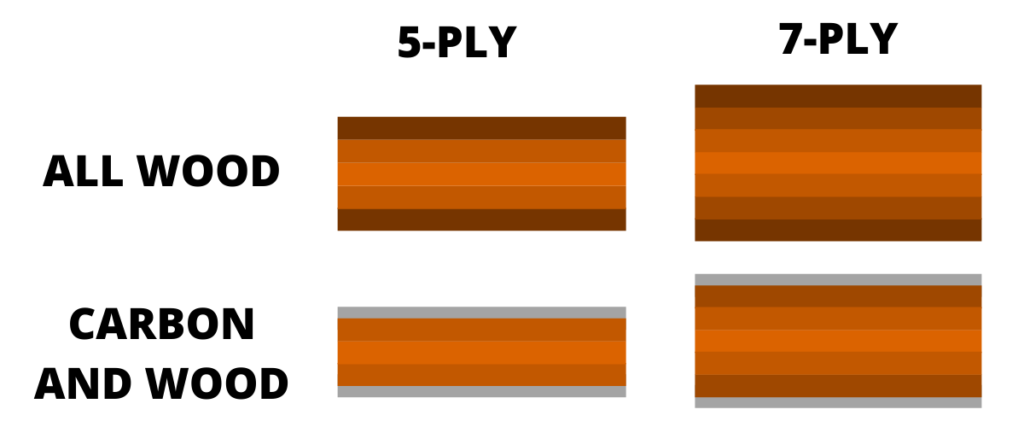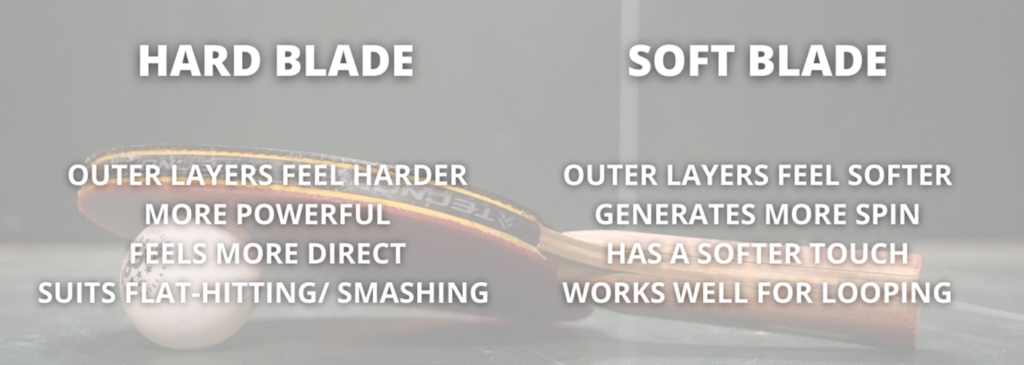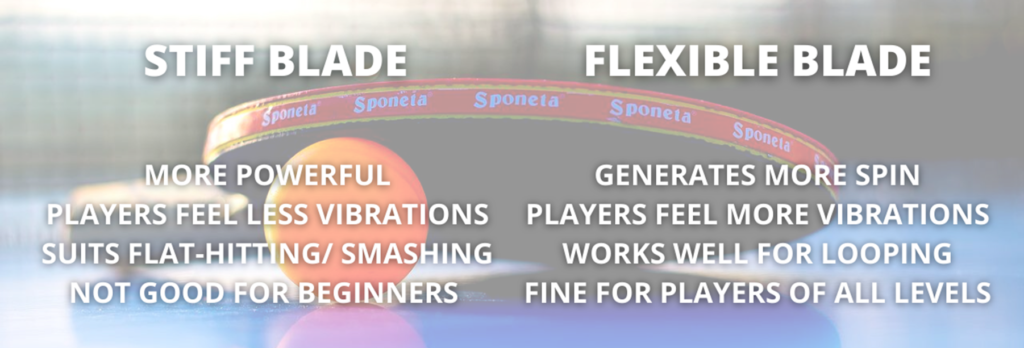Two very important characteristics of a table tennis blade which affect how it feels and performs are it’s hardness and stiffness. But what impact do these characteristics have? And what is the difference between a blade’s hardness and stiffness? In this article, I’ll be addressing everything you need to know.
Blade Hardness and Stiffness Explained
The hardness of a table tennis blade refers to the outer layers, whereas the stiffness refers to the overall flexibility of the blade. Harder blades feel more powerful direct but make it harder to generate spin and maintain control. Stiffer blades generate less spin but produce more power and speed.
Composition of a Table Tennis Blade
A table tennis blade is composed of multiple layers. Typically, a blade will have either 5 layers or 7 layers and be described as either a 5-ply or 7-ply blade respectively.
The layers can vary in two main ways:
- Thickness
- Material
The blade can either be made from all-wood or carbon and wood.
Here are the most common compositions:
- 5-Ply All-Wood
- 7-Ply All-Wood
- 5-Ply Wood and Carbon (3-Ply Wood and 2-Ply Carbon)
- 7-Ply Wood and Carbon (5-Ply Wood and 2-Ply Carbon)
The thickness of each layer will affect both the hardness and stiffness of the blade, as well as the material.

How Does Hardness Affect a Blade’s Performance?
The hardness of a table tennis blade is affected by the two outer layers. The thicker and denser these layers are, the harder the blade will feel. The softer a blade is, the slower it will be but the easier it will be to control.
If a player hits the ball with the exact same stroke using a “soft” blade and a “hard” blade that are the same in every other way, then the harder blade will cause the ball to move faster when it is struck. In other words, the player needs to put less effort into the shot to be able to generate the same amount of speed when using a hard blade compared to using a soft blade.
Softer blades are better for generating spin because they allow the ball to dwell for longer. Hence, for looping a softer blade may be preferred, whereas for flat-hitting and smashing a harder blade is more suitable.

How Does Stiffness Affect a Blade’s Performance
The stiffness of a table tennis blade is affected by how many layers it has, the thickness of the layers and the materials they are made from. Assuming all other variables are kept constant:
- A blade with 7 layers will feel stiffer than a blade with 5 layers
- A thicker blade will feel stiffer than a thinner blade
- Carbon blades feel stiffer than all-wood blades
The stiffness of a blade affects the amount of spin and power it is capable of producing, and how easy it feels to control and how much feedback it provides.
- Stiffer blades are less capable of generating spin compared to more flexible blades.
- Stiffer blades are more powerful meaning the ball will move faster when struck using the same level of force compared to with a more flexible blade.
- More flexible blades can feel easier to control since the ball dwells for longer on the paddle.
- More flexible blades provide more feedback to the player in the way of vibrations.
In general, flexible blades are recommended for players learning new techniques because they offer more “feeling” since the player will feel the vibrations more compared to a stiffer blade. This feedback helps the player improve because they can become familiar with the feeling of successful and unsuccessful shots.

Possible Combinations of Hardness and Stiffness
It is possible to get blades which are described as “hard and stiff”, as well as blades that are described as “soft and stiff”. Hence, there are 4 possible extreme combinations you can get:
- Hard and Stiff
- Hard and Flexible
- Soft and Stiff
- Soft and Flexible
Hard and Stiff Blades
- Usually have a 7-ply composition made from carbon and wood with thick layers.
- This is the most powerful combination which is good for flat-hitting and blocking.
- It produces the least amount of spin and is the hardest to control.
- It offers the least “feeling” since the vibrations are deadened.
Hard and Flexible Blades
- Usually have a 5-ply composition made from carbon and wood with thinner layers. Or may be a 7-ply composition made from very thin layers of carbon and wood.
- Offers a good balance of speed and spin.
- Offers a good amount of “feeling” due to its flexibility.
Soft and Stiff Blades
- Usually have a 7-ply all-wood composition, or a thicker 5-ply all-wood composition.
- Does not offer much feeling due to its stiffness but more so compared to a hard and stiff blade.
- Suitable for all-round players.
- Works for players who want to maintain control but without sacrificing too much power.
Soft and Flexible Blades
- Usually have a 5-ply all-wood composition.
- Offers a high level of spin capability making it great for looping.
- Does not offer much power.
- Provides the player with plenty of feedback.
Here are some more articles you might find useful:
